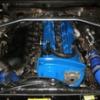Shifting The Powerband
Announcements
-
Similar Content
-
Latest Posts
-
Sorry the pictures suck. So hard to get camera and light in there
-
One of the first jobs with the E39 is making sure the tailgate stays up. In BMW fashion they made a little cavity under the roof to hide the dampers rather than putting them down the side like everybody else. As you can see I have these little cavities that house the dampers. When I cleared one out and vacuumed as much crap as I could out of it I noticed a fair bit of rust. The cavity is bone dry, even after all that rain we had only a few days ago so I'm assuming that whatever allowed the moisture in is fixed but I'd like to treat the rust in there. I was thinking of just blasting it full of rust converter but I didn't know if this would be beneficial considering I can't actually get in there to prep anything. Maybe there's a better product? Thanks guys
-
Had a few skylines over the years anyway bought this a few years ago for skidz i think it’s been around these traps for a while anyway I plan to thrash and trash and I assume it’s going to send me broke good times
-
The stock boost solenoid is just a valve. Power it and it is open. Unpowered, it is closed. When it is closed, there is no boost bleed out through the solenoid back to the inlet. The wastegate sees all the boost pressure, thus you get the wastegate's spring pressure as your boost pressure. 5 psi. When it is open, it lets some boost escape. This causes the static (boost) pressure in the line to the wastegate to be lower than the pressure in the intercooler pipe. There is probably a small restrictor in the solenoid or one of its lines to limit the flow rate of the escaping air, which limits how far the static pressure can fall, which limits the extra boost. The boost has to climb above the original/wastegate setpoint until the wastegate sees 5 psi. You get 7 psi in the intercooler pipework. A manual boost controller is exactly the same setup, just without the ability to change it on-off. It's always set to whatever you set it to. There is a small leak from the boost controller. The more you screw the adjuster in, the more it leaks, the lower the pressure seen at the wastegate and the higher the boost will be. So, yes, your diagrams are correct.
-
By DraftySquash · Posted
Hi everyone, Apologies in advance if this feels like a topic covered multiple times. I'm only asking because some of the old topics I found are missing images now. I'm in the process of getting a manual boost controller (BC). Nothing fancy, just getting a manual one for now as I don't plan to go crazy with it and would not go over 10 PSI. My car is not jacked up on boost steroids to do crazy numbers. I want to understand the OEM setup of the boost solenoid and vacuum lines on the R34 GTT so I know what needs to be changed when I do install the BC. I sketched the current setup to the best I could see and it's on the diagram attached. If the boost controller 'Wastegate Arrow' goes from nipple 1 to 2. My understanding is that the red vacuum line's "F" connector-end should be connected to BC nipple #2? Nipple #1 is meant to have the "pressure source" so what vacuum line would that be? Is it the green vacuum line? From what I have read here, the OEM boost solenoid is not used at this point. So that can come out and then I can just plug the nipple that usually connects to the blue vacuum line? So would the final setup look something like this? Thanks in advance. I don't want to already be knee-deep into pulling out vacuum lines before understanding this. I'm a noob when it comes to boost setups so trying to learn as I go.
-






Recommended Posts
Create an account or sign in to comment
You need to be a member in order to leave a comment
Create an account
Sign up for a new account in our community. It's easy!
Register a new accountSign in
Already have an account? Sign in here.
Sign In Now